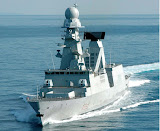Gaitero
Eu Publiquei no FX-2, mas ele nem foi notado entao resolvi publicar aqui tambem.
Aproveitando o documento do nosso amigo, o caça de 5 geração pleiteado pelo Brasil esta muito proximo deste produzido pela MIG, creio que teremos surpresas nos próximos anos e estou convicto de que ela será Russa e não se chamará PaK-Fa.
According to Alexey Fedorov, head of the United Aircraft Corporation, another aircraft designer — MiG Corp. — is developing a lightweight multi-role frontal aircraft (LMFS) , which is said to be similar to the US Joint Strike Fighter. While the PAK FA will replace Russian Air Force's Su-27s, the service's MiG-29 Fulcrum is to be succeeded by the LMFS. Development of the LMFS would follow the PAK FA, with a first prototype flight planned for 2016-17.
Abraço.
Caro Gaitero,ja que voce esta se informando sobre esse assunto,vou colocar um episódio,só para tentar mostrar ao pessoal que não se trata de ficção.
Eu nunca falei sobre isso aqui no DB,pois as vezes pode ficar parecendo conversinha e istórinha

Quando da 1.a viajem do MD Jobim a Europa e Russia,em um domingo,eu estava em um almoço,aqui em São Paulo,e nesse almoço me foi apresentado um cidadão Russo de férias no Brasil com a esposa.Tratava-se de um Matemático,Fisico,Engenheiro Espacial,que naquele momento trabalhava no Projeto do Mig35.

Com a ajuda de sua esposa que ja havia morado no Brasil,pude "ter" uma "conversa" com ele acompanhada de algumas caipirinhas de Vodka,e como todo curioso "primário" fiz aquelas indagações típicas de "amantes do tema" mas "amadores no conteúdo" e algumas delas foram:
Sobre a facilidade da Russia,em transferir tecnologia em uma parceria com o Brasil
Ele riu,e disse que achava dificil acontecer com o Brasil que nunca teve negocios nessa area com eles,mas podia acontecer mas ia custar caro,e que as tranferencias até então feitas a China e India,estavam sendo feitas em "camadas" e que quanto mais se avançava nas camadas, mais caras elas ficavam.E para mim não me iludir pois nem tudo era "desprotegido",mesmo com contratos rígidos,muitos cuidados eram tomados.
Sobre a parceria no Pakfa,ele foi reticente,inclusive (na época) se haveria parceria com a India.Eles haviam apresentado o MiG35,demonstrador na India e ele dava a disputa naquela concorrencia como dura,e sem prognósticos.
Mas afirmou categoricamente que o Pakfa sairia com ou sem parceiros,pois era um projeto do estado Russo.
E ai ele citou que havia um outro projeto de 5.aG do Bureau da MIG,que deveria usar alguns desenvolvimentos em curso no MIG35,inclusive uma versão da turbina vetorada e radar,que já estava caminhando a algum tempo.
Eu falei que desconhecia isso,nunca tinha ouvido falar; ele simplesmente me respondeu,que a estrutura da industria aeronáutica Russa estava se modificando,tanto que ele e outros colegas cientistas trabalhavam em empresas do tipo "prestadora de serviços" para cada parte especifica do projeto MIG35,havendo outros grupos trabalhando assim também.Que era idéia do governo fortalecer os dois maiores centros desenvolvedores de projetos aeronáuticos,a MIG e a Sukoi,fazendo com que eles se desenvolvessem fortes,em paralelo,e que por isso da existencia de outro projeto de 5g,mais "leve" aguardando a chancela oficial,ou
investidores.

Esse "projeto" existe,não é "papo" para a imprensa do Alexey Fedorov,confirmado por alguem que trabalha lá também.
Agora o Brasil participar dele,vai uma fila de caminhões lotados de otimismo e sonhos.

Deus faça.

Sds
Um tempo depois ele me mandou isso por e-mail:
 MiG Pushes Ahead With Light Fighter
MiG Pushes Ahead With Light Fighter
Aviation Week & Space Technology
09/11/2006, page 34
Douglas Barrie
London
Russian air force recognizes Sukhoi T-50 design alone will not meet future fighter needs
Printed headline: Generation Gap
Russian combat aircraft manufacturer MiG could have a prototype of a lightweight fifth-generation fighter ready as soon as 2010, building on classified design work it has been carrying out for several years.
The MiG design, sometimes known within the company as the Light Multifunction Frontal Aircraft (LMFS),is to provide a successor aircraft in the class of the MiG-29 Fulcrum.
Russian air force chief Vladimir Mikhailov confirms the service now intends to pursue two designs, rather than a single, to meet next-generation fighter needs. Sukhoi was initially selected to develop the T-50 as the air force's future fighter. This aircraft, however, is a heavy fighter in the class of the Sukhoi Su-27 Flanker. Mikhailov is quoted in the Russian press as saying MiG will develop a light-fighter to complement the Sukhoi design.
THE SHIFT TO FAVOR a two-tier approach to future fighter procurement reflects a victory for senior management at MiG. Company executives have been lobbying the air force to promote this strategy for several years. "People are beginning to understand the need for a second type of fighter," one senior MiG executive told Aviation Week & Space Technology.
Russian air force "endorsement" will also help MiG in the export arena. Both MiG and Sukhoi have already briefed India on their respective fifth-generation fighter programs. New Delhi, however, is unlikely to opt for a Russian aircraft that is not--at least tacitly--supported by the military in Moscow.
MiG had originally been the incumbent designer to provide a successor to the Su-27, with the 1.42 Multi-role Frontal Fighter (MFI). Conceived in the latter years of the Cold War, one prototype of the 30-ton fighter was to be completed before cancellation in 1997.
MiG is working on a fifth-generation design in the same weight class as its MiG-29 Fulcrum, which the company is also continuing to upgrade. Credit: MiG
The collapse of the MFI program eventually turned MiG's attention to a direct Fulcrum replacement, though until comparatively recently the company's precarious finances were not able to support a full-scale development program. As far as LMFS is concerned, MiG has yet to receive any state support.
One company official says all work so far on the light fifth-generation fighter is being financed from its own funds.
Various configurations have been wind-tunnel tested. A company source suggests it is settling on a twin-engine design, with a dry weight of around 10 tons. The design includes thrust vector control, along with a "big wing" to increase maneuverability. Inward and outward canted fin variants of the basic design have also been examined, as has a tail-less configuration. A prototype, he suggests, could be completed within 30 months, with adequate funding. Engine manufacturer Klimov submitted a proposal for an engine for the LMFS earlier this year.
Many of the avionics and weapons systems in development for the T-50, or the PAK FA, as it is sometimes referred to, will also be applicable to MiG's light fighter.
In terms of air-to-air armament, Vympel, now part of Russia's Tactical Missile Corp., is working on upgrades of presently fielded weapons, as well as successor designs. Gennady Sokolovsky, Vympel's general director until recently, revealed some of its plans at a conference in Moscow earlier this year. Sokolovsky appears to have revealed more than either the Russian Defense Ministry or Vympel intended because company officials remain reticent to discuss several of the program designations Sokolovsky detailed.
THE COMPANY IS WORKING on a new short-range air-to-air missile, referred to as K-MD and Izdeliye (Item) 300. This program likely corresponds to the K-30 designation. This weapon is to enter service in the first half of the next decade. Further development of the R-73 design continues--likely as a stopgap, and also for export.
Vympel is working on a substantial upgrade of its R-77 (AA-12 Adder) radar-guided air-to-air missile, likely in line with the Izdeliye 180/K-77M designations. This may see the missile's signature lattice control fins replaced by conventional surfaces. Range will also be increased, and an upgraded radar seeker and improved electronic countermeasures will be included.
The Russian air force has only a limited stock of the basic R-77, likely drawn from production runs of the export version of the missile, known as RVV-AE.
While the Izdeliye 300 and the Izdeliye 180 will be applicable to the LMFS, the third class of AAM alluded to by Sokolovksy will be limited to the PAK FA, and possibly the MiG-31 Foxhound. Izdeliye 810 is a long-range AAM in the class of the R-33/K-37 (AA-9 Amos/AA-X-13).








